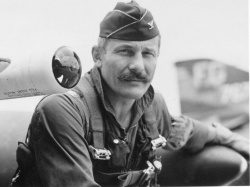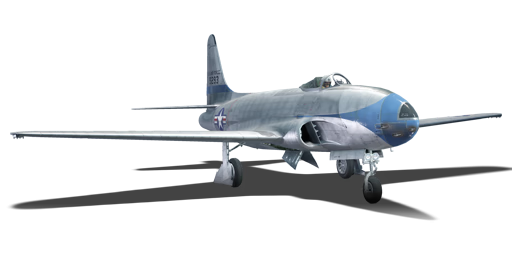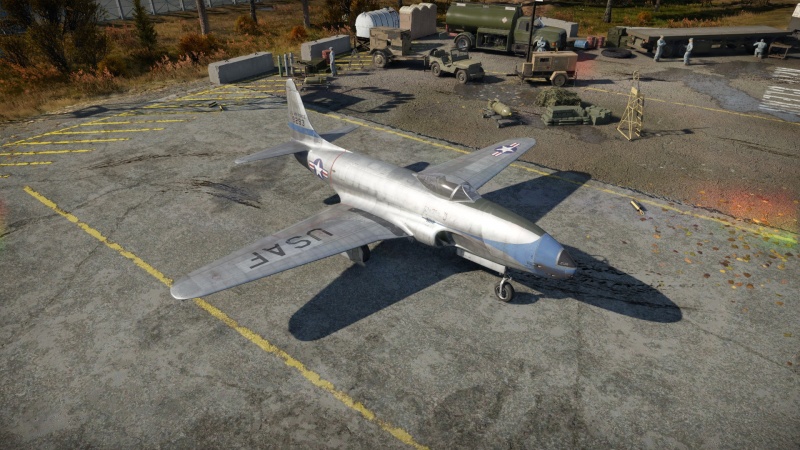Difference between revisions of "F-80C-10"
(Updated format) |
m (→External links) |
||
| Line 201: | Line 201: | ||
== External links == | == External links == | ||
| − | ''Paste links to sources and external resources, such as:'' | + | <!--''Paste links to sources and external resources, such as:'' |
* ''topic on the official game forum;'' | * ''topic on the official game forum;'' | ||
* ''encyclopedia page on the aircraft;'' | * ''encyclopedia page on the aircraft;'' | ||
| − | * ''other literature.'' | + | * ''other literature.''--> |
| + | |||
| + | * [https://forum.warthunder.com/index.php?/topic/264991-lockheed-f-80c-10/ Official data sheet - more details about the performance] | ||
{{AirManufacturer Lockheed}} | {{AirManufacturer Lockheed}} | ||
{{USA jet aircraft}} | {{USA jet aircraft}} | ||
Revision as of 16:28, 24 January 2021
| This page is about the aircraft F-80C-10. For the other version, see F-80A-5. |
Contents
Description
The F-80C-10 Shooting Star is a rank V American jet fighter with a battle rating of 7.7 (AB/RB) and 7.3 (SB). It was introduced in Update 1.33.
The greatest performance upgrade from the A-5 to the C-10 is that the C-10 comes with WEP. This additional power significantly increases acceleration, allowing you to match that of the British Meteor series. It also allows for a last-resort method to escape if you happen to get jumped on. However, maximum power WEP only lasts for about 2 minutes, and once that runs out, the thrust increase by the less powerful WEP (now visible in gray instead of red), is not as significant.
General info
Flight performance
| Characteristics | Max Speed (km/h at 0 m - sea level) |
Max altitude (metres) |
Turn time (seconds) |
Rate of climb (metres/second) |
Take-off run (metres) | |||
|---|---|---|---|---|---|---|---|---|
| AB | RB | AB | RB | AB | RB | |||
| Stock | 891 | 883 | 12500 | 24.3 | 25.5 | 18.7 | 17.3 | 850 |
| Upgraded | 915 | 903 | 23.7 | 24.0 | 32.2 | 25.2 | ||
Details
| Features | |||||
|---|---|---|---|---|---|
| Combat flaps | Take-off flaps | Landing flaps | Air brakes | Arrestor gear | Drogue chute |
| ✓ | ✓ | ✓ | ✓ | X | X |
| Limits | ||||||
|---|---|---|---|---|---|---|
| Wings (km/h) | Gear (km/h) | Flaps (km/h) | Max Static G | |||
| Combat | Take-off | Landing | + | - | ||
| 990 | 380 | 560 | 560 | 360 | ~11 | ~5 |
| Optimal velocities (km/h) | |||
|---|---|---|---|
| Ailerons | Rudder | Elevators | Radiator |
| < 482 | < 600 | < 640 | N/A |
Engine performance
| Engine | Aircraft mass | |||||
|---|---|---|---|---|---|---|
| Engine name | Number | Empty mass | Wing loading (full fuel) | |||
| Allison J33-A-35 | 1 | 4,160 kg | 194 kg/m2 | |||
| Engine characteristics | Mass with fuel (no weapons load) | Max Takeoff Weight | ||||
| Weight (each) | Type | 6m fuel | 20m fuel | 21m fuel | ||
| 814 kg | Centrifugal-flow turbojet | 4,548 kg | 5,398 kg | 5,458 kg | 6,962 kg | |
| Maximum engine thrust @ 0 m (RB / SB) | Thrust to weight ratio @ 0 m (WEP) | |||||
| Condition | 100% | WEP | 6m fuel | 20m fuel | 21m fuel | MTOW |
| Stationary | 1,980 kgf | 2,396 kgf | 0.53 | 0.44 | 0.44 | 0.34 |
| Optimal | 1,980 kgf (0 km/h) |
2,396 kgf (0 km/h) |
0.53 | 0.44 | 0.44 | 0.34 |
Survivability and armour
- 12.7 mm steel - behind the pilot
- 10 mm steel - in front of the pilot
- 38 mm bulletproof glass - armoured windscreen
Modifications and economy
Armaments
Offensive armament
The F-80C-10 is armed with:
- 6 x 12.7 mm M3 Browning machine guns, nose-mounted (300 rpg = 1,800 total)
Suspended armament
The F-80C-10 can be outfitted with the following ordnance:
- Without load
- 8 x HVAR rockets
- 2 x 1,000 lb AN-M65A1 bombs (2,000 lb total)
Usage in battles
Like most American fighters, your best option to attack is Boom and Zoom. At the start of the match, fly out towards the edge of the map. Climb at 2-3 degrees until you have reached ~770 km/h (~420 knots) at ~910 metres (~3,000 ft), then zoom climb at 20-30 degrees. Once you have slowed down to 287 km/h (155 kt), continue to climb at a solid 10 degrees. Optimally, you should have between 3.7-4.9 km (12,000-16,000 ft) depending on how high the highest enemy is, before turning in towards the area of conflict (continue to climb or maintain altitude). Only once you have selected a target should you dive and make your pass. Always keep your energy high, whether it be speed or altitude. Because the F-80 is frequently uptiered to 9.0, the best option is to dive on unsuspecting targets that are occupied engaging your teammates.
Defensive flying, rolling scissors, and to some degree, turn fighting, are options with the hydraulic boosters upgrade, as the straight wing as compared to 9.0 jets with swept wings provides better manoeuvrability at medium speeds (463-648 km/h, 250-350 knots). Any higher and the control surfaces begin to stiffen, any lower and you risk stalling out first, as jets with higher BR generally have a better thrust-to-weight ratio.
If you are given an awkward firing angle (e.g.: your target is near ground level and you are diving at a steep angle) or you fail to destroy them on your first pass, slowly pull your aircraft back up into a straight vertical climb to recover as much altitude as possible. If you persist on knocking out your target, you risk crashing into the ground from control stiffening or getting strafed by another enemy because you are losing your energy in a dogfight.
Pros and cons
Pros:
- Good acceleration and climb rate
- Effective weapons
- Can outturn Mig-15's when the need arises
Cons:
- Relatively slow dive speed
- Average level flight speed
- Poor turn rate at 4-500 km/h
- Overall useless in a uptier, it is just too slow
- Just 100 seconds of WEP in RB, it is only there for emergencies
History
In-game description
An all-metal, single-seat fighter-bomber with one turbojet engine. The aircraft was created by a group of Lockheed engineers (headed by Clarence "Kelly" Johnson) in only 143 days.
The first flight of the XP-80 prototype was performed in January 1944. The first production version, designated the P-80A Shooting Star, entered service in 1946. The P-80 became the first combat-capable jet aircraft to enter service with the USAAF.
1947 saw the appearance of the next production version of the aircraft, the P-80B. The ninth production P-80A-1 was converted to a new prototype, designated the XP-80B. It had an Allison J33-A-17 turbojet engine producing 1,816 kg of thrust, equipped with a methanol-water injection system. The airfoil was thinner, but the skin's thickness was increased. To install a water mixture tank, the plane's fuel quantity had to be sacrificed by reducing it from 1,781 to 1,610 liters The aircraft also received a Lockheed-designed ejection seat and a cockpit air-conditioning system.
The plane's armament consisted of six 12.7 mm Colt-Browning M3 machine guns with 300 rounds each in the forward fuselage. One 1,000 lb (454 kg) bomb or ten 5-inch (127 mm) unguided HVAR missiles could be suspended under each wing panel.
A total of 240 P-80B fighter-bombers were built from March 1947 to March 1948, including P-80B-1s and 31 P-80B-5s. The В-5 variant was intended to be operated in Arctic conditions; its heated canopy prevented icing. In addition, special types of oil and special rubber were used to operate the aircraft in low temperature conditions.
At least five P-80Bs were equipped with a guidance system for Bell GAM-63 RASCAL air-to-surface missiles. Externally, these aircraft differed in the shape of the forward fuselage and the wing-mounted tanks. Also, they were fitted with extra spoilers on the upper and lower wing surfaces.
In June 1948, when the US military aircraft designation system was changed, the P-80B was renamed to the F-80B.
When the Korean War started, F-80Bs were stationed in the USA and in Europe, being used by the USAAF mainly for training purposes. Later, 117 F-80Bs were brought up to the F-80C's standards and re-designated "F-80C-12". The remaining F-80Bs were withdrawn from service by the end of 1951.
Notable pilots

Media
Excellent additions to the article would be video guides, screenshots from the game, and photos.
See also
Links to the articles on the War Thunder Wiki that you think will be useful for the reader, for example:
- reference to the series of the aircraft;
- links to approximate analogues of other nations and research trees.
External links
| Lockheed Corporation | |
|---|---|
| Fighters | XP-38G · P-38E · P-38G-1 · P-38J-15 · Bong's P-38J-15 · P-38K · P-38L-5-LO · YP-38 |
| Bombers | B-34 · PV-2D |
| Jet Fighters | F-80A-5 · F-80C-10 |
| F-104A · F-104C | |
| Strike Aircraft | F-117 |
| Export / License | A-29 · ▄Hudson Mk V |
| ␗P-38L-1 | |
| ␗F-104A · ▀F-104G · ␗F-104G · ▄F-104G · ▅F-104J · ▄F-104S | |
| The Lockheed Corporation merged with Martin Marietta Corporation in 1995 to form Lockheed Martin Corporation. | |
| See Also | SABCA · Mitsubishi Heavy Industries · Fiat Aviation |
| USA jet aircraft | |
|---|---|
| Fighters | |
| F9F | F9F-2 · F9F-5 · F9F-8 |
| F-80 | F-80A-5 · F-80C-10 |
| F-84 | F-84B-26 · F-84F · F-84G-21-RE |
| F-86 | F-86A-5 · F-86F-25 · F-86F-2 · F-86F-35 |
| F-89 | F-89B · F-89D |
| F-100 | F-100D |
| F-104 | F-104A · F-104C |
| F-4 | F-4C Phantom II · F-4E Phantom II · F-4J Phantom II · F-4S Phantom II |
| F-5 | F-5A · F-5C · F-5E · F-20A |
| F-8 | F8U-2 · F-8E |
| F-14 | F-14A Early · ▄F-14A IRIAF · F-14B |
| F-15 | F-15A · F-15C MSIP II · F-15E |
| F-16 | F-16A · F-16A ADF · F-16C |
| Other | P-59A · F2H-2 · F3D-1 · F3H-2 · F4D-1 · F11F-1 |
| Strike Aircraft | |
| FJ-4 | FJ-4B · FJ-4B VMF-232 |
| A-4 | A-4B · A-4E Early |
| A-7 | A-7D · A-7E · A-7K |
| AV-8 | AV-8A · AV-8C · AV-8B Plus · AV-8B (NA) |
| A-10 | A-10A · A-10A Late · A-10C |
| F-111 | F-111A · F-111F |
| Other | A-6E TRAM · F-105D · F-117 |
| Bombers | |
| B-57 | B-57A · B-57B |





